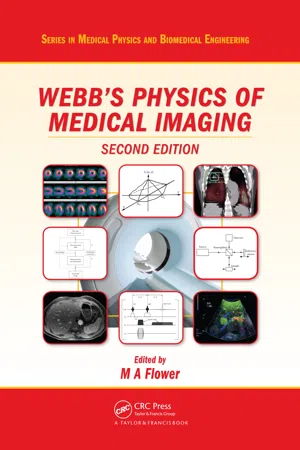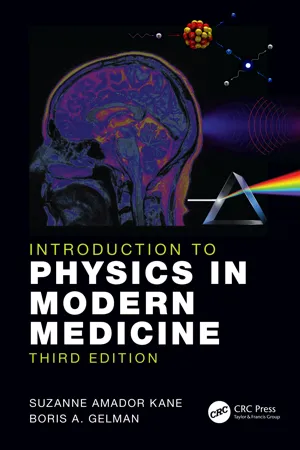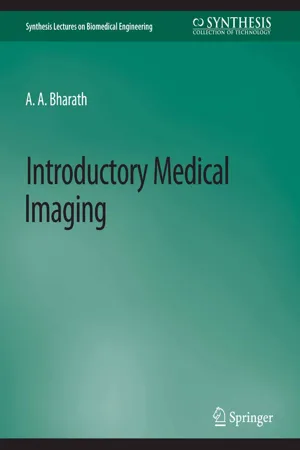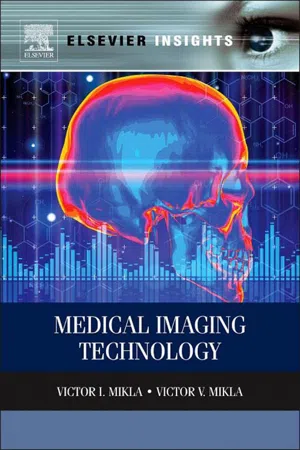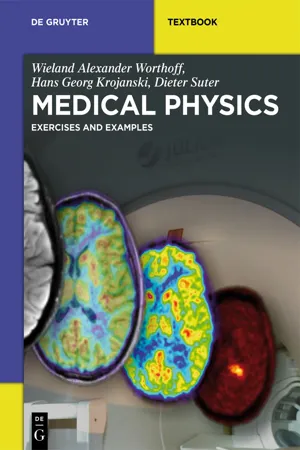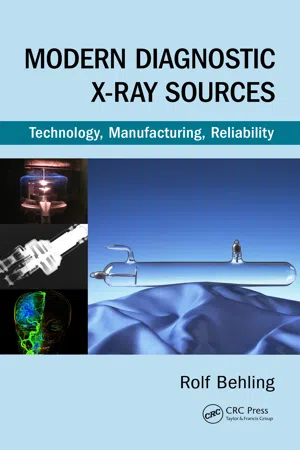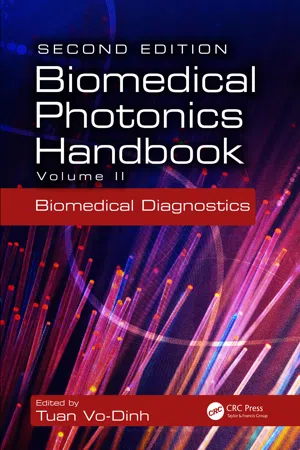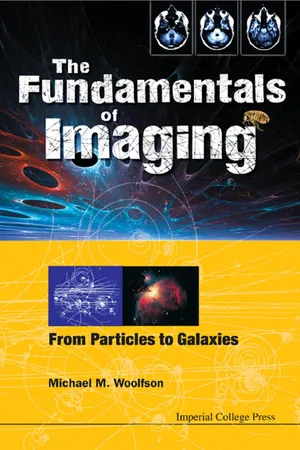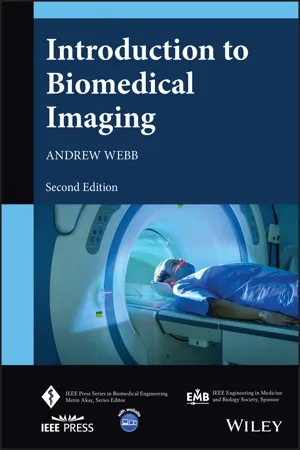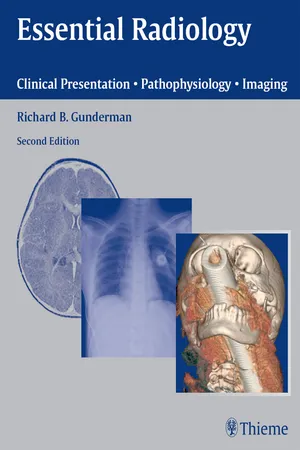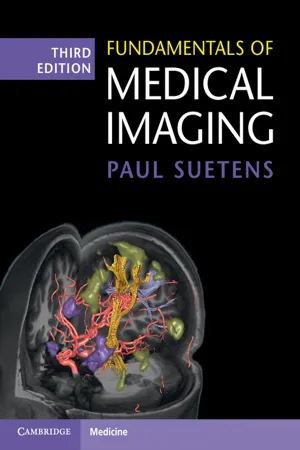Physics
Diagnostic X-Rays
Diagnostic X-rays are a form of electromagnetic radiation used in medical imaging to create detailed images of the inside of the body. They are produced by directing a controlled amount of radiation through the body, with different tissues absorbing or transmitting the radiation to varying degrees. These images help in diagnosing and monitoring various medical conditions.
Written by Perlego with AI-assistance
Related key terms
1 of 5
12 Key excerpts on "Diagnostic X-Rays"
- eBook - PDF
- M Flower(Author)
- 2016(Publication Date)
- CRC Press(Publisher)
91 References ....................................................................................................................................... 91 15 Diagnostic Radiology with X-Rays In view of this place in history as well as the vast application of X-rays, it is appropri-ate to begin the discussion of the physics of medical imaging by considering diagnostic radiology with X-rays. In later chapters, we shall see how many of the concepts formed for describing radiography with X-rays are also useful for other modalities. In a sense, the language of imaging was framed for X-radiology, including concepts such as image contrast and noise and spatial resolution, and it has subsequently been taken across to describe these other techniques for imaging the human body. This chapter covers both the essential physics of the design of X-ray imaging equipment and the quality control of the equipment. Quality control is an important component of modern radiographic practice, facilitating the maintenance of the quality of the image and the radiation protection of patients and staff. The radiographic image is formed by the interaction of X-ray photons with a photon detector and is therefore a distribution of those photons, which are transmitted through the patient and are recorded by the detector. These photons can be either primary pho-tons, which have passed through the patient without interacting, or secondary photons, which result from an interaction in the patient (Figure 2.1). The secondary photons will in general be deflected from their original direction and, for our purposes, can be consid-ered as carrying no useful information.* The primary photons do carry useful informa-tion. They give a measure of the probability that a photon will pass through the patient without interacting and this probability will itself depend upon the sum of the X-ray attenuating properties of all the tissues the photon traverses. - eBook - ePub
- Suzanne Amador Kane, Boris A. Gelman(Authors)
- 2020(Publication Date)
- CRC Press(Publisher)
In the more than 100 years since Roentgen’s discovery, x-ray imaging has reigned as the preeminent diagnostic method of modern medicine. X-ray imaging is so widely used that virtually every reader of this book has had at least one diagnostic x-ray, while every year about seven out of every ten US citizens receive at least one x-ray. As these numbers indicate, x-rays remain a workhorse of medical imaging, providing low-cost glimpses inside the body where ultrasound cannot penetrate and fiber optic scopes cannot go.Radiography – the science of medical x-ray images – was revolutionized in the 1970s by the widespread introduction of computed tomography (CT ), a computerized technique that permits the reconstruction of three-dimensional images using x-rays. With the invention of the CT scanner, x-ray imaging has become an even more sophisticated and sensitive probe of anatomy and function. Using a combination of CT and magnetic resonance imaging (MRI) (Chapter 8 ), physicians can noninvasively analyze the anatomy of any part of the body, including the brain. The wide utility of CT has led to an explosive growth in its use, with an estimated 80 million or more CT scans per year estimated to occur in the US alone. Increasingly, CT is being combined with other methods of imaging, such as positron emission tomography (PET) (Chapter 6 ), to provide complementary imaging of body anatomy and function or pathology.The basic idea behind taking Diagnostic X-Rays is quite simple. Radiographs – x-ray images colloquially called “x-rays” – are two-dimensional shadow images created on photographic films by x-rays whose energy has been partially absorbed by the body organs and tissues (Figure 5.1a ). The resulting image is a projection of all of the radiopaque (x-ray-absorbing) objects in the x-ray’s path. Since there is no way to detect if one object was in front of or behind another, the two overlap on the image. This means that Diagnostic X-Rays inherently lose depth information, and provide only a flattened planar image of the body (Figure 5.1b ). CT scans can distinguish between the many structures that overlap on a diagnostic x-ray, presenting instead a cross-sectional view of body anatomy (Figure 5.1c - eBook - PDF
- Anil Bharath(Author)
- 2022(Publication Date)
- Springer(Publisher)
3 C H A P T E R 2 Diagnostic X-Ray Imaging The contents of this chapter are, essentially, the following: • Basic principles of X-Ray Imaging: Introduction to terminology and mode of operation. • X-Ray physics: Quantum nature; X- Ray interactions with matter; X-Ray spectra; energy range for diagnostic use. • X-Ray image quality parameters: general requirements on physical parameters; image Sig- nal/Noise (S/N); image contrast. • X-Ray production: functional design requirements;tube construction; target selection. • Image receptors: functional design requirements; film-based receptors; image intensifiers. • Patient dosage: trade-offs with image quality; noise and dosage; effective dose equivalent. 2.1 BASIC PRINCIPLES OF X-RAY IMAGING In the simplest case, an X-ray imaging system requires • X-Ray Source • A patient to image • Film (image receptor) • Radiologist/Diagnostician 2.1.1 IDEAL DESCRIPTION OF IMAGING PROCESS X-Rays are generated within the tube, and they are directed towards the patient. As the x-ray photons pass through the patient, some are absorbed, others scattered, and some pass through the patient with no interaction. The transmitted photons i.e., those which do not interact with the patient) are detected (received) by the photon receptor, usually based around film. The formation of an image on the film is dependent on the number of photons which are captured (detected) by the receptor: areas of the film which are dark have received a large number of photons; brighter areas have received fewer. The distribution of the light and dark areas on film is approximately a projection onto a two- dimensional map of the three-dimensional distribution of attenuating structures within the patient. As we shall see, there are many aspects which complicate the simplistic, ideal situation: 4 CHAPTER 2. DIAGNOSTIC X-RAY IMAGING • Statistical arrival of photons (Poisson process). • Photon scatter. • Lines of projection are not parallel i.e., one has beam divergence). - eBook - ePub
- Victor I. Mikla, Victor V. Mikla(Authors)
- 2013(Publication Date)
- Elsevier(Publisher)
1Advances in Imaging from the First X-Ray Images
X-rays as well as other forms of radiation continue to play a crucial role in medical and experimental science. X-rays are electromagnetic radiations having wavelengths roughly within the range from 0.05 to 100 Å. Their similarities to light led to the tests of established wave optics: polarization, diffraction, reflection, and refraction. Thanks the development of sophisticated computer technology, it is now possible to combine thousands of 2D X-ray slices into a 3D image for greater accuracy in pinpointing the location of tumors, bone breaks, and other internal ailments of the human body. X-rays are also widely used outside of the medical field. The wavelength of X-rays is comparable to the size of atoms. Therefore, they are ideally suited for probing the structural arrangement of atoms and molecules in a wide range of materials. The sections of this review are presented in a logical order beginning with the discovery of X-rays, followed by selected experimental details, with the final sections covering diagnostic radiology physics and other, nonmedical, applications. Roentgens story is widely known, but people who helped lay radiology’s foundations remain essentially anonymous, especially to younger physicists and physicians.Keywords
X-ray; diffraction; radiology; chest radiography; fluoroscopy; mammography; exposure dosimetry1.1 X-Rays—Early History
The true start of imaging, medical and nonmedical, as we consider it today was in 1895 when Roentgen discovered the X-ray in his Wurzburg laboratory on November 8. Almost immediately after Wilhelm Conrad Roentgen announced the discovery of the X-ray, imaging techniques based on the discovery were implemented all over the world. For example, chest radiography became one of those early applications, even though the equipment seems crude by comparison to that of today, and certainly there was no knowledge of the potential deleterious effects of the ionizing radiation of X-rays. Roentgen’s invention heralded the start of the modern era of medical imaging. - Angela Newing(Author)
- 1999(Publication Date)
- ICP(Publisher)
Chapter 2 X-RAYS FOR DIAGNOSIS Requirements for Diagnostic X-Rays X-rays arising from interactions in the inner parts of atoms in the target give a broad spectrum of radiation whose maximum energy depends upon the kilovoltage applied to the tube. Characteristic X-rays are of much less importance in diagnostic radiology than bremsstrahlung except in certain specialised techniques such as mammography. Higher kilovoltages give increased X-ray energy and greater penetration in body tissues, but with lower contrast (differential absorption) between different types of tissue. Thus, for best effectiveness, Diagnostic X-Rays should have: 1. Penetrating power (kV) which can be varied over a wide range. 2. Intensity which is similarly variable. 3. Time durations which are very accurately controlled. (Very short times are sometimes necessary because voluntary or invol-untary movements by the patient would blur the picture.) 4. A very small effective source (focal spot) to avoid geometric blurring which would arise with a large source. Principles As X-rays interact with, and pass through, the human body their attenuation varies depending upon the densities and atomic numbers of the intervening structures. As shown in Chap. 1, the linear attenuation coefficient is proportional to the number of atoms per unit volume, and this is one of the 29 30 Light, Visible and Invisible reasons why bone attenuates an X-ray beam more than soft tissue. The average densities of bone and soft tissue are 1.8 and 1.0 respectively. What is considerably more important with X-rays of the relatively low energies used for diagnostic work, is differences in atomic number. In this energy range, materials of higher atomic number provide attenuation largely through photoelectric absorption, whereas Compton scatter is the dominant process for low atomic number materials.- eBook - PDF
Medical Physics
Exercises and Examples
- Wieland Alexander Worthoff, Hans Georg Krojanski, Dieter Suter(Authors)
- 2013(Publication Date)
- De Gruyter(Publisher)
| Part II: The Physics of Diagnostics and Therapy 7 X-Ray Diagnostics and Computer Tomography Shortly after the discovery of X-rays by Wilhelm Conrad Röntgen on November 8, 1895, their significance to medical diagnostics was recognized. Using these diagnostic tech-niques, the part of the body under investigation is irradiated with X-rays; the attenu -ated radiation is then detected behind the body. As this attenuation is determined by the electron density in living beings, it is influenced principally by heavy atoms. Due to this effect, for example, bones are markedly different from the soft tissue that sur-rounds them. This tissue, in turn, can be further investigated through the introduction of contrast agents (as in, for example, coronary angiography). The first digital system of projection radiography was digital subtraction angiography (DSA), with which a clean image of the network of vessels can be obtained. In computer tomography (CT), many different projection X-ray recordings can be taken by rotating the source of the X-rays and the detector around the object under investigation. From these readings, a three-dimensional image that represents electron density is calculated. An X-ray tube is comprised of a high-vacuum tube in which a heatable cath -ode and an anode are located. Between the cathode and the anode, a voltage 𝑈 of 10–150 kV is usually applied, and a current of 1−2,000 mA . Due to the thermoelectric effect, electrons flow out from the cathode. These electrons are accelerated through the high voltage. When the beam of electrons strikes the anode, X-rays are created. The majority of these incident electrons transfers their energy through interaction with the electron shells of the anode material, which heats up as a result. A small portion of the electrons is slowed down in the field of the atomic nuclei of the anode material. - eBook - PDF
Modern Diagnostic X-Ray Sources
Technology, Manufacturing, Reliability
- Rolf Behling(Author)
- 2015(Publication Date)
- CRC Press(Publisher)
The Interaction of X-Rays with Matter 84 Medical imaging with X-rays is based on the generation of contrast by sending a “probe” of photons into a volume, capturing and analyzing the outgoing X-radiation. This analysis may comprise the simple recording of patterns of attenuation and also other characteristics such as distribu-tion of scattered radiation, spectral modulation, and phase shift. In any case, the result is spatially resolved information about the object. It is convenient to consider the X-ray probe as a spatially delimited shower of photons; a beam. The absence of proper lenses makes this assumption suspi-cious, however. As discussed below, there are no suitable lenses available for human imaging. Hence, an X-ray “beam” for human imaging is always divergent. It travels rectilinearly in air and nearly on straight paths in human tissue. Under the assumption that the dimensions of the source are small with respect to the distance r , the intensity I ( r ) obeys a square distance law, as shown in Figure 3.1, where I ( r → 0) denotes the intensity in an infinitesimal distance to a realistic source: ) ( = A I r I r ( 0) 2 . (3.1) However, the X-ray source is often extended, and the above law may deliver false expectations. When illuminating a patient with X-rays scattered radiation may emerge from wide areas close to the skin. Theoretically, an infinitely large planar source would cause constant intensity independent of the distance. Scattered radiation from a patient, which is illuminated with a delimited beam, decreases less rapidly with distance compared with the point source of Equation 3.1. - eBook - PDF
Biomedical Photonics Handbook
Biomedical Diagnostics
- Tuan Vo-Dinh(Author)
- 2014(Publication Date)
- CRC Press(Publisher)
415 13.1 Introduction X-ray diagnostic imaging is one of the most important tools in modern medicine. Approximately 120,000 x-ray systems are in operation in the United States, performing an estimated 240 million x-ray procedures each year. X-ray diagnostic imaging is based on the tissue-differential contrast generated by x-ray and tissue interaction. In Section 13.2, x-ray–tissue interaction and tissue contrast are presented. In addition to the tra-ditional coverage of x-ray attenuation-based tissue contrast, the section also details x-ray phase-based tissue contrast arising from the nature of x-ray as a wave, which is especially appropriate due to the recent research focus on x-ray phase imaging. Next, Section 13.3 examines x-ray generation, spectra, and exposure control, followed by projection x-ray imaging, both radiography and fluoroscopy (R&F); digital imaging detectors; examines x-ray generation, spectra and exposure control. Section 13.4 details projection x-ray imaging, both radiography and fluoroscopy, as well as digital imaging detectors, x-ray image intensifiers (IIs) and signal-to-noise ratio (SNR) analysis of projection imaging. Finally, Section 13.5 presents in-line phase-contrast imaging, which is an emerging x-ray imaging modality with great potential for biomedical applications. 13.2 Biological Tissue–X-Ray Interaction and Tissue Contrast 13.2.1 Attenuation-Based Tissue Contrast X-rays are ionizing and invisible electromagnetic radiation with much shorter wavelengths than light. A simple relationship exists between the energy E and the wavelength λ of an x-ray photon: λ = 12 4 . ( ) ( ) . E keV Å (13.1) 13 X-Ray Diagnostic Techniques 13.1 Introduction ...................................................................................... 415 13.2 Biological Tissue–X-Ray Interaction and Tissue Contrast ......... - eBook - PDF
Fundamentals Of Imaging, The: From Particles To Galaxies
From Particles to Galaxies
- Michael Mark Woolfson(Author)
- 2011(Publication Date)
- ICP(Publisher)
14.3. Recording a Radiographic Image The danger of overexposure to x-radiation has already been men-tioned. Very high-energy photons can disrupt DNA in cells and produce harmful mutations that cause various kinds of cancer. In normal life there is background radiation from various sources so small doses of x-radiation for diagnostic purposes do not appreciably add to the overall risk but large doses are best avoided. For this rea-son most x-ray images are produced with short bursts of radiation lasting only a few microseconds. The traditional way of recording a diagnostic x-ray image is with film. The desirable film characteristics are that it should be high-speed, so that fewer photons are required to produce the image thus reducing the patient’s exposure, and also that it should give a resolu-tion that matches the diagnostic requirements. Unfortunately these properties are usually incompatible — high-speed films also tend to give lower resolution. For this reason it is normal to use x-ray film in contact with a screen coated with a phosphor that converts the impinging x-radiation into visible light to which the film is more sensitive. Another way of viewing a weak image is with an x-ray image intensifier, the form of which is illustrated in Fig. 14.5. A low-intensity x-ray image is formed on an input screen that has the property that it is conducting, so that it can serve as a cathode, and also has its inner surface coated with a material such as caesium iodide (CsI) that readily emits photoelectrons — electrons ejected from the CsI by x-ray photons. The energy of the photoelectrons is greatly increased by accelerating them through a large potential dif-ference, typically 30 kV, while at the same time focusing them to all move through the same point so that the spatial distribution of elec-trons retains the form of the image. The high-energy electrons then - eBook - PDF
- Andrew Webb(Author)
- 2022(Publication Date)
- Wiley-IEEE Press(Publisher)
23 2 X-ray Imaging and Computed Tomography 2.1 General Principles of Imaging with X-rays X-ray imaging is a transmission-based technique in which X-rays generated by a source pass through the patient and strike a flat panel detector (FPD) placed underneath the patient, as shown in Figure 2.1a. Contrast in the image arises from differential attenuation of X-rays as they pass through different tissues. For example, X-rays are very efficiently attenuated in bone but much less so in soft-tissue, as shown in Figure 2.1b. In planar X-ray radiography, the image produced is a simple two-dimensional projection of the tissues lying between the X-ray source and the detector. Planar X-ray radiography is used for a number of different purposes including the assessment of possible bone fractures, chest radiography for diseases of the lung, intravenous pyelography (IVP) to detect diseases of the genitourinary tract including kidney stones, and X-ray fluoroscopy (in which images are acquired continuously over a period of several minutes) for image-guided interventional surgeries such as pacemaker placement. For many clinical diagnoses, three-dimensional volumetric imaging of thin slices with good soft tissue contrast is required. In these cases, X-ray computed tomography (CT) is used. The basic principles of CT are shown in Figure 2.2a. The X-ray source and detectors together rotate around the patient, producing a series of one-dimensional transmission projections. The patient bed continuously slides through the rotating source/detector plane to give a three-dimensional data set through the body in only a few seconds. These data are reconstructed to give a series of two dimensional images, which can also be visualized as a 3D surface, as shown in Figure 2.2b. The strengths of CT as an imaging modality include: (i) very high spatial resolution (<1 mm), (ii) very fast acquisition times (brain <1 s, whole body ∼10 s) Introduction to Biomedical Imaging, Second Edition. - eBook - PDF
Essential Radiology
Clinical Presentation Pathophysiology Imaging
- Richard B. Gunderman(Author)
- 2011(Publication Date)
- Thieme(Publisher)
Throughout most of radiology’s history, detection and dis-play of photon shadows were combined in a single step: the film. As radiology makes the transition to the digital age, these two functions can be separated, permitting the optimization of each. Computer monitors are replacing radiographs and light-boxes as the preferred way to view images. Using picture archiving and communication systems (PACS), images are ac-quired, stored, and retrieved electronically, making images available anytime and anywhere. The display function can be further subdivided into image production and image process-ing. For example, when a CT examination is performed, the ini-tial data acquired bear no resemblance whatsoever to a med-ical image. The image acquired with CT results from the ability of a powerful computer to perform countless computations necessary to assemble the data into a CT image. Once an image is produced, however, further processing is possible to opti-mize desired image characteristics, such as the contrast be-tween soft tissue structures. This accounts for the difference between so-called soft tissue windows, bone windows, and lung windows on a chest CT examination. Through postimag-ing processing, it is also possible to “reconstruct” the data ac-quired in one plane (in CT, generally the axial plane) in other planes (e.g., the coronal or sagittal planes) ( Fig. 1–8 ). Penetrating Light X-rays are a form of electromagnetic radiation ( Fig. 1–9 ). In medicine, they are produced when electrons boiled off from a tungsten cathode filament are accelerated by a potential difference into a tungsten anode, with which they collide. These collisions result in the production of a considerable amount of heat, but a small percentage of the electronic energy is converted into x-ray radiation (generally 1%). Hence, the cathode functions in electron production, and the rotating anode functions in converting electron energy into x-rays. - eBook - PDF
- Paul Suetens(Author)
- 2017(Publication Date)
- Cambridge University Press(Publisher)
Chapter 2 Radiography 2.1 Introduction X-rays were discovered by Wilhelm Konrad Röntgen in 1895 while he was experimenting with cathode tubes. In these experiments, he used fluorescent screens, which start glowing when struck by light emitted from the tube. To Röntgen’s surprise, this effect persisted even when the tube was placed in a carton box. He soon realized that the tube was emit- ting not only light, but also a new kind of radiation, which he called X-rays because of their mysterious nature. This new kind of radiation could not only travel through the box. Röntgen found out that it was attenuated in a different way by various kinds of materials and that it could, like light, be captured on a photographic plate. This opened up the way for its use in medicine. The first “Röntgen picture” of a hand was made soon after the discovery of X- rays. No more than a few months later, radiographs were already used in clinical practice. The nature of X-rays as short-wave electromagnetic radiation was established by Max von Laue in 1912. 2.2 X-rays X-rays are electromagnetic waves. Electromagnetic radiation consists of photons. The energy E of a photon with frequency f and wavelength λ is E = h.f = hc λ , (2.1) where h is Planck’s constant and c is the speed of light in vacuum; c ≈ 300,000 km/s, hc = 1.2397 × 10 −6 eV m. The electromagnetic spectrum (see Fig- ure 2.1) can be divided into several bands, starting with very long radio waves, used in magnetic reso- nance imaging (MRI)(see Chapter 4), extending over microwaves, infrared, visible and ultraviolet light, X-rays, used in radiography, up to the ultrashort- wave, high energetic γ-rays, used in nuclear imaging (see Chapter 5). The wavelength for X-rays is on the order of Angstrøms (10 −10 m) and, consequently, the corresponding photon energies are on the order of keV (1 eV = 1.602 x 10 −19 J). X-rays are generated in an X-ray tube, which consists of a vacuum tube with a cathode and an anode (Figure 2.2(a)).
Index pages curate the most relevant extracts from our library of academic textbooks. They’ve been created using an in-house natural language model (NLM), each adding context and meaning to key research topics.
